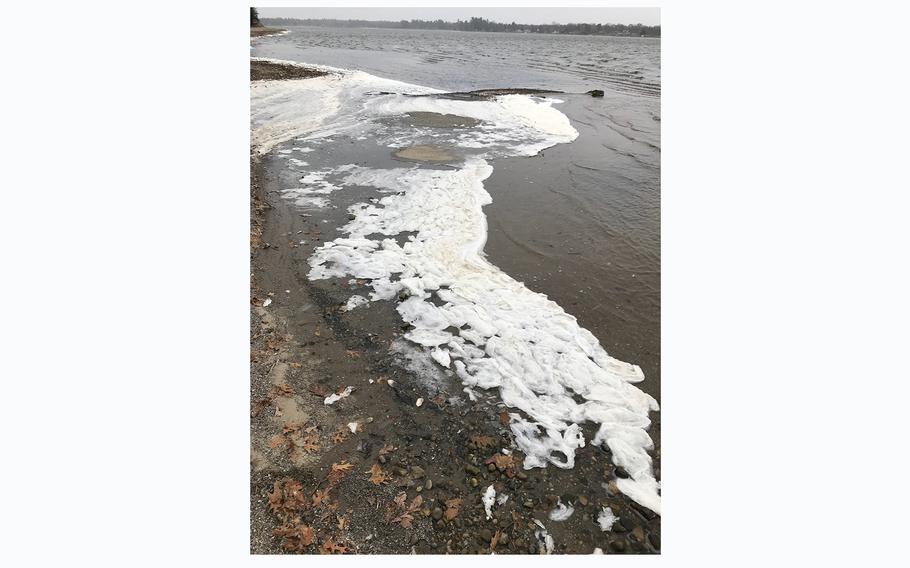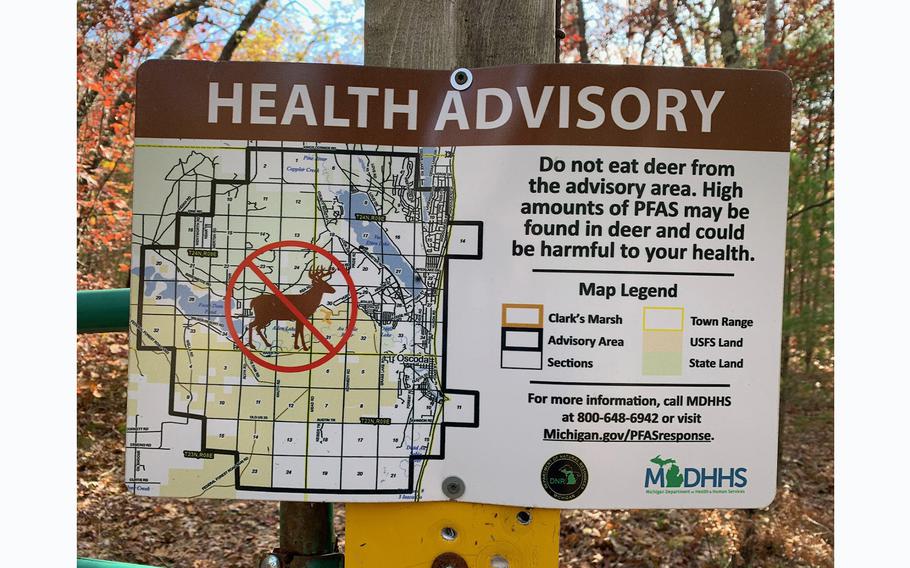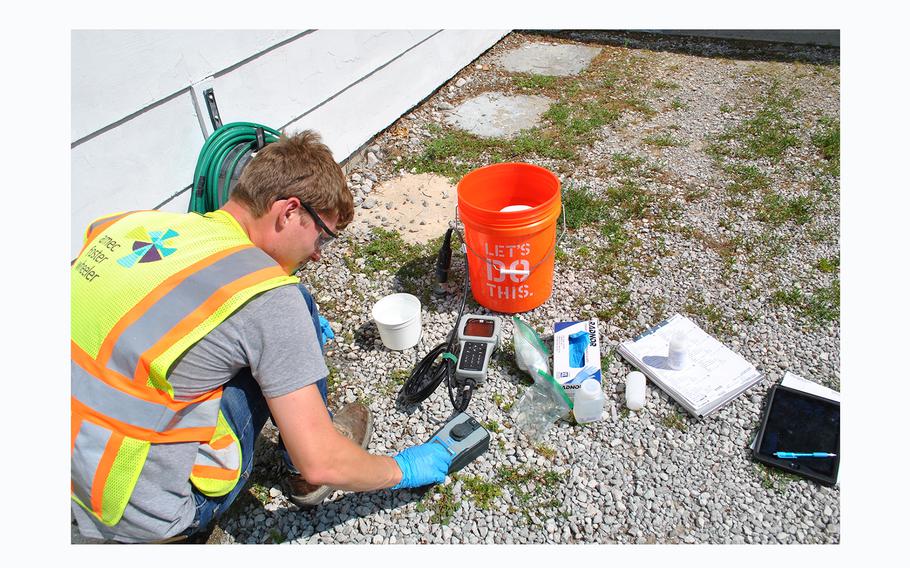U.S.
Inside the Pentagon’s painfully slow effort to clean up decades of PFAS contamination
KFF Health News December 27, 2023

PFAS foam collects on the shore of Van Etten Lake in Oscoda, Michigan. The lake is next to the former Wurtsmith Air Force Base, from which PFAS was found seeping into the surrounding community. (Tony Spaniola/TNS)
(Tribune News Service) — Oscoda, Michigan, has the distinction as the first community where “forever chemicals” were found seeping from a military installation into the surrounding community. Beginning in 2010, state officials and later residents who lived near the former Wurtsmith Air Force Base were horrified to learn that the chemicals, collectively called PFAS, had leached into their rivers, lakes, and drinking water.
Thirteen years later, the community is still waiting on whatever it will take to clean its water. As a result of dogged activism and pressure from government officials, the Air Force has finally taken initial steps simply to contain the chemicals.
Wurtsmith is just one of hundreds of contaminated U.S. military sites. Under congressional pressure, the Defense Department has acknowledged it has a big mess to clean up. It has spent years trying to grasp the scale of the contamination and assess the costs U.S. taxpayers will shoulder to clean it all up. Further, there’s no clear scientific agreement on how to destroy the chemicals, even as companies pitch their scientists’ best solutions in a bid for a share of billions of dollars in looming government contracts.
“We’re really at the forefront,” said Tony Spaniola, a lawyer turned activist whose family owns a home across Van Etten Lake from the former base. “There has been gross mismanagement of this entire program — a lot of stonewalling, a lot of foot-dragging.” He added: “In the meantime, this stuff is continuing to spew into groundwater continuously, into lakes, rivers.”
PFAS chemicals have been linked to increased cholesterol levels, preeclampsia in pregnant women, decreased birth weights, and decreased immune response to vaccines, as well as certain types of cancer. A federal study of U.S. military personnel published in July was the first to show a direct connection between PFAS and testicular cancer, and the chemicals have been linked to increased risk of kidney cancer.
Pentagon Has Lacked ‘Urgency’
Despite rising concerns over the potential effects of these substances, Pentagon officials have defended their use as a matter of national security, asserting in a report to Congress in August that banning them would undermine military readiness.
As many as 600 active or former military installations and adjacent communities are or may be contaminated with per- and polyfluoroalkyl substances, or PFAS. The chemicals are found in a bevy of products used by the U.S. military for decades, including industrial solvents, stain retardants, waterproofing compounds, and firefighting foam.
While the Pentagon was aware of the potential health effects of PFAS as early as the 1970s, the individual military services didn’t begin responding to PFAS pollution at bases until 2014. More than nine years into the Defense Department’s work to analyze its contamination problem and plan for cleanup, frustrated advocates and community residents continue to worry about the safety of their drinking water.
“There hasn’t been an urgency from the DOD that we’ve seen to actually clean up their mess,” said Jared Hayes, a senior policy analyst with the Environmental Working Group, an advocacy organization that focuses on pollution issues nationwide.
The Defense Department did not respond to questions about the pace of the cleanup or provide updated cost estimates.

A health advisory sign posted at Clark’s Marsh, south of the former Wurtsmith Air Force Base, states that deer should not be eaten due to the potential for “high amounts of PFAS” in the meat, and shows a map of the surrounding area. (Tony Spaniola/TNS)
A spokesperson said the Pentagon is committed to addressing its PFAS contamination. “The Department recognizes the importance of this issue and is committed to addressing PFAS in a deliberative, holistic, and transparent manner,” Jeff Jurgensen wrote in an email to KFF Health News.
Cleanup Costs Balloon
By June 30, the Defense Department had determined that 359 of 714 active and former bases and National Guard facilities were polluted with PFAS and 107 didn’t meet a threshold for action. Investigations are underway at the remaining 248 sites, with nearly all results expected by year’s end, according to Defense Department records.
Cleanup cost assessments have ballooned as the list of contaminated installations grows and researchers work to develop technologies to remove or destroy the toxic compounds. The Defense Department estimated in 2016 that the “total cleanup liability” — only a portion of which applies to PFAS cleanup — was $27.3 billion.
But according to a Sept. 21 letter from 52 members of Congress, that estimate climbed to $38.7 billion by 2022.
The House version of the Pentagon’s fiscal year 2024 funding bill includes more than $1.1 billion for cleanup of PFAS and contaminants such as PCBs, dioxins, and radiation at active and former installations, while the Senate’s version would boost the military’s PFAS-specific $250 million funding request by more than $67 million to address water contamination. The legislation has yet to pass, mired in congressional debate over the fiscal 2024 appropriations process.
“DOD has a massive backlog of cleanup at their sites and the funding just wasn’t adding up. … The amount of funding that they are putting toward cleaning up the problem isn’t matching the need of the problem,” Hayes said, referring to an analysis conducted by EWG.
A November analysis of Pentagon data found that the extent of the contamination may even be broader, with tests showing thousands of samples from private wells near military installations contained levels of PFAS that the Environmental Protection Agency considers unsafe.
The EPA has proposed stringent limits on multiple types of PFAS, including PFOA and PFOS, in drinking water. The new standard, expected to take effect by the end of the year, would set a cap of 4 parts per trillion for those two compounds. Meanwhile, the Pentagon has been evaluating its sites using a 2016 EPA health advisory of 70 parts per trillion.
If the EPA limit becomes the standard, the Defense Department will need to incorporate it into the review, planning, and cleanup process, Jurgensen said.
But activists, including Spaniola, are pushing the Biden administration to start the cleanup process even while investigations are ongoing. In a July memorandum, Brendan Owens, assistant secretary of defense for energy, installations, and environment, directed the Defense Department to find locations near current and former bases where PFAS can be extracted from groundwater and soil while a cleanup plan is developed.

Water sampling in process at the former Wurtsmith Air Force Base, Michigan, Aug. 1, 2017. (Breanne Humphreys/U.S. Air Force)
At Wurtsmith — the first military site where contamination was discovered — officials started by installing two groundwater treatment systems, adding to a handful of other pumps installed over the years.
The two systems won’t destroy the chemicals, but they will stop some of the flow of contaminated groundwater into Van Etten Lake from a landfill and a repository that once held discarded or unused equipment, according to Air Force officials.
As for completely ridding the environment of PFAS chemicals, a long, bumpy road remains.
‘Multiple Decades of Cleanup’
For years, the Defense Department had disposed of the chemicals by burning them in incinerators. In 2018, the Defense Department paid contractors to begin work to incinerate more than 2 million gallons of stockpiled firefighting foam. In 2021, Congress ordered the Pentagon to stop the practice in anticipation of new EPA guidelines for PFAS disposal and destruction, which the agency says it expects to update this winter, but the Pentagon lifted its moratorium on incineration on July 11.
Studies have shown burning the chemicals can release toxic gases into the air.
In suspending the moratorium, the Defense Department said it had found four commercially available options for effectively burning PFAS.
EPA spokesperson Tim Carroll said in a statement the agency understands the Pentagon needed to provide guidance to its personnel regarding destruction and disposal of PFAS.
But communities already affected by PFAS contamination should be protected when making decisions about how to dispose of the chemicals, according to the statement.
“EPA understands that DoD considers high temperature incinerators to be an effective destruction option,” Carroll said. “EPA notes that, at this time, it is difficult to determine whether high temperature incinerators are an effective PFAS destruction option because data on PFAS releases from incinerators are generally lacking.”
Besides incinerating waste, injecting it deep into the earth, and putting it in landfills, a number of companies are testing technologies they hope will work to destroy PFAS. Among those methods is supercritical water oxidation, known as SCWO, which oxidizes organic compounds at high temperatures.
Conventional incineration plants are “nowhere close to being able to destroy PFAS,” said Zhuoyan Cai, director of Denmark-based Aquarden Technologies, which he said is currently in talks with U.S. companies about its SCWO technology. “The PFAS is used in firefighting foam, so it’s highly thermally resistant, so it’s very difficult to just burn it away in a traditional plant.”
Supercritical water is essentially a fourth state of water under extremely high pressure and temperature — different from ice, liquid water, and steam — with special characteristics that dissolve oil and other organic compounds, including PFAS and pesticides.
When wastewater is under those conditions, the salts fall away and the oils and pesticides blend into the supercritical water. Mix in oxygen and it reacts aggressively and rips the PFAS carbon bonds apart, with greater than 99.999% destruction, Cai said. A study from EPA scientists said the method “could be a permanent solution for PFAS-laden wastewaters.”
A handful of companies are working with the Pentagon to bring mobile SCWO technology to widespread use, including Revive Environmental, a spinoff of the Ohio-based nonprofit Battelle, and 374Water, which originated from research at Duke University in North Carolina.
“Unfortunately, we as a society are still manufacturing and selling [PFAS] into the market. So I think the first thing we need to do is stop putting it in our ecosystem,” 374Water’s board chairman, Kobe Nagar, said. “It’s multiple decades of cleanup.”
Other companies are developing and testing their own approaches, using everything from ultraviolet light to plasma.
Dallas-based AECOM, a consulting firm that handles PFAS response work for the U.S. military, uses electrodes to break down the chemicals by removing electrons.
But Rosa Gwinn, global PFAS technical lead at AECOM, cautioned that none of these emerging technologies is a perfect response to the cleanup predicament. “There is not going to be a single solution, no matter what somebody says,” she said.
But as industry chases billions of dollars in government contracts, towns like Oscoda linger under a cloud of health concerns with little action.
Well over a decade after the discovery of the chemicals surrounding Wurtsmith, a bounty of public health warnings about PFAS exposure remain, including for drinking water, fish and wildlife, and the chemical-laced foam that still washes ashore. One site now finally being targeted is a beach with a YMCA camp for children, Spaniola said.
“Am I concerned for my health? Yes,” he said. “Am I concerned for my family’s health? Yes.”
KFF Health News, formerly known as Kaiser Health News (KHN), is a national newsroom that produces in-depth journalism about health issues and is one of the core operating programs of KFF — the independent source for health policy research, polling and journalism.
©2023 KFF Health News
Distributed by Tribune Content Agency, LLC.